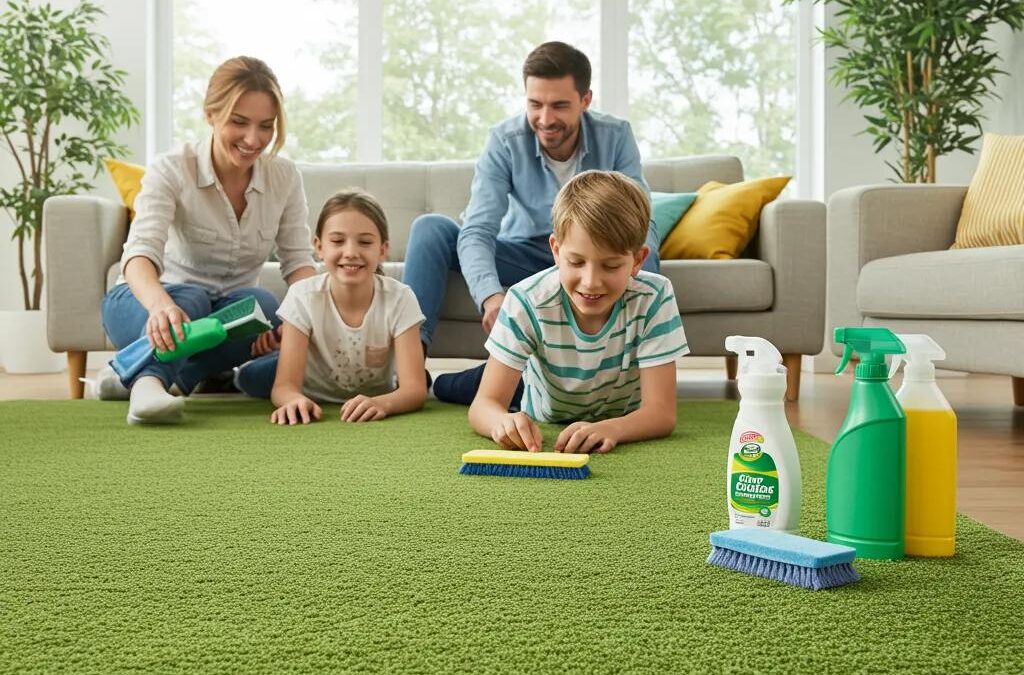Looking for a carpet cleaning service that’s tough on dirt but gentle on your family and the planet? Green carpet cleaning uses safe, biodegradable products to tackle deep-down grime while protecting your home’s air quality and the environment. If you’re wondering whether to go with a standard carpet cleaning company or an eco-friendly option, this guide is for you. We’ll explore how green cleaning delivers amazing results without the worry of harsh chemicals. You’ll learn about water use, drying times, health and environmental benefits, effective green techniques, the downsides of traditional cleaners, and how to make the switch. Whether you want the healthiest home possible or the longest-lasting carpet fibers, we’ll break down the key differences, health perks, environmental considerations, effective methods, potential risks, and what’s new in carpet care for 2025.
What’s the Big Difference Between Green and Traditional Carpet Cleaning?
Green carpet cleaning relies on cleaning agents derived from plants and biodegradable detergents that break down dirt without leaving behind harmful residues. Traditional carpet cleaning often uses solvents made from petroleum and chemicals like chlorine, which can remove dirt but release volatile organic compounds (VOCs) into your home. The best choice depends on whether you prioritize immediate stain removal or long-term indoor air quality and a healthier environment.
Let’s take a quick look at how they stack up:
| Method | Cleaning Agents | Water Use | Drying Time | Residue Risk | Indoor Air Impact |
|---|---|---|---|---|---|
| Green Carpet Cleaning | Plant-based cleaners, enzymes | Less water | 1–3 hours | Minimal | Improves air quality |
| Traditional Carpet Cleaning | Harsh chemicals (e.g., perchloroethylene) | More water | 6–12 hours | Significant | Releases VOCs |
This comparison helps highlight the trade-offs before we dive into the specifics.
How Does Green Carpet Cleaning Actually Work with Safe, Natural Products?
Green carpet cleaning uses special formulas with enzymes and biodegradable surfactants. These work together to break down tough stains like oils and proteins right at the source. Enzymes target the bonds in protein-based stains, while plant-based surfactants surround and lift away dirt particles. This method is gentle on your carpet fibers and helps them dry faster because it doesn’t leave excess moisture. For instance, enzyme cleaners break down pet stain proteins into simple components that can be easily rinsed away, leaving no chemical residue behind. Plus, these non-toxic solutions contribute to a healthier home by avoiding common respiratory irritants.
What Chemicals Are Typically Found in Traditional Carpet Cleaning?
Traditional carpet cleaning often involves chemicals like perchloroethylene, naphthalene, butoxyethanol, and formaldehyde. Perchloroethylene is a solvent used to break down tough grime, but it’s considered a potential carcinogen. Naphthalene and butoxyethanol are degreasers that can release irritating fumes. Formaldehyde is sometimes used to set stains but can off-gas for days. While these strong chemicals can be effective at removing stains, they pose risks to your home’s air quality, your family’s health, and the environment.
Emissions of Volatile Organic Compounds from New Carpets This study was conducted to quantify the volatile organic compound (VOC) emissions released by new carpets. Samples of four typical carpets, including two with styrene-…Emissions of volatile organic compounds from new carpets measured in a large-scale environmental chamber
The emissions from new carpets are a significant concern for indoor air quality, highlighting the importance of understanding the chemical composition of cleaning agents used on them.
How Do Water Usage and Drying Times Compare Between the Two Methods?
Green carpet cleaning often uses techniques like low-moisture encapsulation or controlled hot water extraction, which means less water is used and carpets dry much faster. Traditional steam cleaning, on the other hand, uses a lot of water—sometimes 2–3 gallons per room—which can lead to very long drying times. Eco-friendly methods typically use less than a gallon per room and can have your carpets dry in just 2–4 hours. Using less water helps prevent mold and mildew growth, while also conserving a valuable resource and saving energy.
Is Steam Cleaning Considered Green or Traditional?
Steam cleaning, also known as hot water extraction, can be either green or traditional depending on the cleaning solutions used. When it’s combined with enzyme-based, plant-derived detergents, it becomes an eco-friendly method that uses hot water to activate the natural cleaning agents. However, if the process involves solvent-based pre-sprays and chemical conditioners, it falls into the traditional category. So, the key is what’s in the bottle: Steam Cleaning + Biodegradable Detergents = Green. Steam Cleaning + Chemical Solvents = Traditional.
What Are the Health Benefits of Choosing Green Carpet Cleaning?
Green carpet cleaning helps create a healthier home by avoiding the toxins found in conventional cleaners. It reduces your exposure to potentially harmful chemicals, allergens, and irritants, leading to better indoor air quality and supporting those with sensitivities. Choosing non-toxic carpet care is a smart step towards a healthier living space and greater peace of mind.
How Does Green Cleaning Improve Indoor Air Quality and Reduce VOC Exposure?
Green cleaning effectively removes odors and trapped particles without releasing harmful volatile organic compounds (VOCs) into your air. The plant-based cleaners break down dirt and rinse away cleanly, leaving minimal to no off-gassing. Enzyme-based solutions work to neutralize odor-causing agents like pet dander and mold spores instead of just masking them or spreading them around. The result? Your indoor air quality improves noticeably, reducing the chances of headaches, dizziness, and long-term respiratory issues linked to VOC exposure.
Why Is Green Carpet Cleaning Safer for Kids and Pets?
Green carpet cleaning services use ingredients that are safe for contact with sensitive skin and developing respiratory systems. Their non-toxic formulas avoid harsh irritants like glycol ethers and chlorine, which can trigger asthma and skin reactions in children and pets. Simply put: Green Carpet Cleaning = Safe for Kids and Pets. This means families can get back to enjoying their living spaces right away, without having to wait for dangerous chemical fumes to clear.
Can Green Cleaning Help Reduce Allergies and Breathing Problems?
Absolutely! Green cleaning is excellent at reducing allergens by thoroughly removing common culprits like dust mites, pollen, and mold spores using enzyme-based detergents that break down allergy-causing proteins. The low-moisture methods also prevent the dampness that encourages allergen growth. Many people with allergies report fewer symptoms after green carpet treatments, showing how sustainable care can lead to better breathing and more comfort at home.
What Are the Environmental Impacts of Green vs. Traditional Carpet Cleaning?
Green carpet cleaning helps reduce your environmental footprint by using less water, protecting local waterways, and using products that break down naturally. Traditional methods, however, often release wastewater filled with chemicals that can harm soil health and aquatic life. Choosing eco-friendly solutions means your carpet care aligns with a commitment to a healthier planet.
Sustainable versus Conventional Cleaning: Environmental Impacts practices, underscoring the superior performance of green alternatives. This is evident in the reduction of emissions and other environmental impacts observed in this study. The findings indicate a significant contribution to reducing the environmental footprint of cleaning services. Sustainable vs. Conventional Cleaning in Healthcare: Microbiological and Life Cycle Insights, R Fontana, 2025
Studies have demonstrated that sustainable cleaning practices significantly reduce environmental impacts compared to conventional methods, highlighting the benefits of green alternatives.
How Does Green Cleaning Reduce Water Use and Pollution?
Green cleaning methods, like low-moisture encapsulation, use very little water—sometimes less than a quart per square yard—and often filter and reuse rinse water. The biodegradable detergents used break down safely in wastewater treatment systems, preventing harmful chemicals from reaching our rivers and lakes. In short: Green Cleaning = Less Water Used and Less Pollution. Your home benefits, and the environment does too.
What Happens When Harsh Chemicals Get into Our Soil and Waterways?
Traditional cleaning chemicals, such as perchloroethylene and butoxyethanol, can linger in wastewater and settle in riverbeds, harming aquatic life and disrupting the natural balance of soil. These chemicals can kill beneficial bacteria, harm fish, and even build up in the food chain. The consequence is clear: Harsh Chemicals = Waterway Pollution and Damaged Soil Quality. This can have long-lasting negative effects on our environment.
How Do Biodegradable Products Help Protect the Environment?
Biodegradable carpet cleaners are designed to break down into harmless components, allowing natural processes to convert them into water, carbon dioxide, and biomass. Surfactants derived from plants degrade quickly, preventing them from polluting our environment long-term. This natural breakdown process is crucial for protecting ecosystems and meeting environmental standards.
Which Eco-Friendly Carpet Cleaning Methods Work Best?
The top green cleaning techniques offer excellent results while being kind to the environment. These include hot water extraction paired with enzyme pre-treatments, low-moisture encapsulation, dry compound cleaning, and natural-ingredient rinses. Each method has its own strengths for performance and sustainability.
How Does Hot Water Extraction Work as a Green Cleaning Method?
When used as a green method, hot water extraction utilizes high-temperature water to activate natural, biodegradable detergents. This process helps loosen dirt and grime effectively. A powerful vacuum then extracts the dissolved soils and cleaning solution. This approach provides a deep clean without harsh solvents, helping your carpet fibers last longer and dry more quickly.
What Is Low-Moisture Encapsulation and How Does It Benefit Carpets?
Low-moisture encapsulation involves using special polymer-based detergents that trap dirt particles as they dry. Once the carpet is dry, the crystallized dirt and detergent are easily vacuumed away. This method uses significantly less water, dries carpets in under two hours, and prevents the over-wetting that can lead to mold. Your carpets stay cleaner for longer with minimal moisture left behind.
How Does Dry Compound Cleaning Compare in Eco-Friendliness and Effectiveness?
Dry compound cleaning uses absorbent powders mixed with mild cleaning agents that are spread over the carpet. Dirt sticks to the powder, which is then removed with a special brush and vacuum. This method uses no water at all, meaning no wastewater or chemical runoff. It’s an effective, low-impact option, especially for carpets that aren’t heavily soiled.
What Natural Ingredients Are Used in Green Carpet Cleaning?
You’ll often find natural ingredients like baking soda, white vinegar, citrus extracts, and plant-based enzyme blends in green carpet cleaners. Baking soda is great for absorbing odors and lifting light dirt. Vinegar can help neutralize residues. Citrus oils can boost cleaning power and leave a fresh scent. These natural ingredients work together to clean effectively and safely.
What Are the Risks and Downsides of Traditional Carpet Cleaning?
Traditional carpet cleaning can come with health and environmental drawbacks, mainly due to harsh chemical residues, long drying times, and excessive water use. While they can tackle heavy dirt, these methods can negatively impact your indoor air quality, the lifespan of your carpets, and the environment.
What Health Risks Are Linked to VOCs and Chemicals Like Perchloroethylene?
Exposure to perchloroethylene and other VOCs can lead to headaches, breathing difficulties, dizziness, and potentially long-term damage to your liver or kidneys. These chemicals are known neurotoxins and probable carcinogens, and they can significantly worsen your indoor air quality for days after cleaning.
How Do Chemical Residues Affect Carpet Lifespan and Indoor Air Quality?
Harsh cleaning detergents and solvents often leave behind sticky residues that attract more dirt, causing your carpets to get dirty faster and leading to wear and tear on the fibers. These leftover chemicals can continue to release fumes, degrading your indoor air quality and triggering allergic reactions. Carpets cleaned with strong chemicals may need more frequent cleaning and might need to be replaced sooner.
What Environmental Problems Come from Wastewater and Chemical Runoff?
Wastewater from traditional cleaning methods carries solvents and harsh stain removers into storm drains, eventually polluting rivers and soil. This discharge harms aquatic life, reduces biodiversity, and puts a strain on water treatment facilities. In essence: Chemical Runoff = Environmental Pollution, and Wastewater Discharge = Burden on Infrastructure.
How Do Traditional Methods Contribute to Skin Irritation and Breathing Problems?
Chemical residues left in carpets can cause skin irritation and worsen asthma symptoms. Volatile chemicals like butoxyethanol release fumes that can irritate your airways and skin. Regular exposure can increase the risk of chronic respiratory issues and skin reactions, especially for those who are sensitive.
How Can You Switch to Green Carpet Cleaning for Your Home?
Making the move to green carpet cleaning involves choosing professional eco-friendly services, understanding the limits of DIY methods, comparing long-term costs, and finding certified providers. This change leads to healthier indoor spaces and more sustainable home care.
When Should You Opt for Professional Green Carpet Cleaning Services?
Professional green carpet cleaning services use specialized equipment, precise temperature control, and advanced enzyme formulas for superior results. They ensure thorough stain removal, often come with service guarantees, and adhere to strict eco-certifications. For high-traffic areas or tough stains, professional services offer the best performance and minimal disruption.
What Are Effective DIY Green Carpet Cleaning Tips and Their Limits?
DIY green cleaning is best suited for tackling small spots and light maintenance. Simple home remedies include using a baking soda and vinegar paste to neutralize odors or applying an enzyme cleaner to pet stains. However, without professional equipment, DIY methods might leave behind moisture or residues that could lead to mold or incomplete cleaning.
How Do Costs Compare Between Green and Traditional Carpet Cleaning Over Time?
While green carpet cleaning might have a slightly higher initial cost, it often leads to lower long-term expenses. This is because it can extend your carpet’s life, reduce allergy-related health costs, and mean less frequent professional cleanings. Over a few years, eco-friendly treatments can actually save you 15–25% compared to repeated traditional services. The key takeaway: Green Cleaning = Lower Long-Term Costs.
Where Can You Find Reliable Green Carpet Cleaning Services Near You?
You can find local green carpet cleaning services that are certified by reputable organizations like EcoLogo or Green Seal. Searching online for “green carpet cleaning services near me” and checking their certifications will help you find trusted professionals. Certified providers follow strict environmental and health standards to ensure you get the best results.
What Are the Latest Industry Trends and Future Innovations in Carpet Cleaning?
The carpet cleaning industry is heading towards more automation, advanced low-moisture systems, powerful enzyme-based formulas, and recognized eco-certifications. The focus for 2025 and beyond is on efficiency, sustainability, and proven effectiveness.
How Is the Green Carpet Cleaning Market Growing and Changing?
The global market for green carpet cleaning is growing steadily, fueled by increasing environmental awareness and a greater focus on indoor health. Consumers are actively seeking out certified green services and want to know exactly what’s in the products being used in their homes. This trend means: More Eco-Awareness = Higher Demand for Green Services.
What Technological Innovations Are Driving Eco-Friendly Cleaning?
Exciting innovations like robotic cleaners that precisely dose solutions, new nano-encapsulation surfactants, and advanced biodegradable enzyme boosters are making cleaning more powerful while using less water and energy. Automated systems with smart sensors can even adjust cleaning settings in real time, improving both efficiency and environmental care.
What Certifications and Standards Ensure Quality Green Carpet Cleaning?
Reputable green carpet cleaning services often carry certifications such as Green Seal, EcoLogo, or EPA’s Safer Choice. These standards mean the products use low-VOC formulas, eco-friendly packaging, and have passed rigorous performance tests. Certified companies are regularly audited by third parties to ensure they meet these high environmental and health benchmarks, giving you confidence in their services.
Green carpet cleaning offers a smart solution that combines environmental responsibility, health protection, and excellent cleaning performance. By understanding the methods, benefits, and differences between green and traditional approaches, you can make informed choices that lead to healthier indoor spaces and more sustainable living. Switching to eco-friendly carpet cleaning not only helps your carpets last longer but also aligns your home maintenance with modern environmental values. Choosing green today means cleaner carpets and a clearer conscience for tomorrow.



